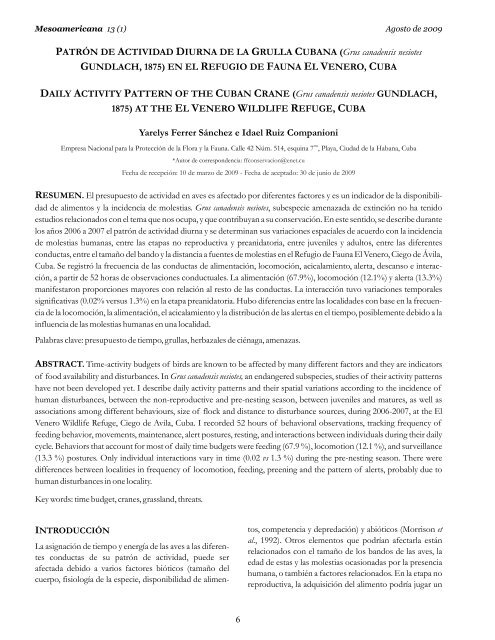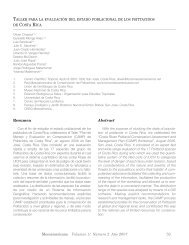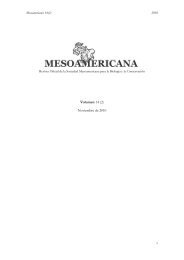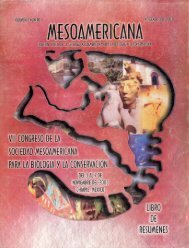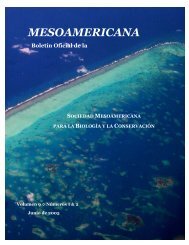MESOAMERICANA - Sociedad Mesoamericana para la BiologÃa y la ...
MESOAMERICANA - Sociedad Mesoamericana para la BiologÃa y la ...
MESOAMERICANA - Sociedad Mesoamericana para la BiologÃa y la ...
You also want an ePaper? Increase the reach of your titles
YUMPU automatically turns print PDFs into web optimized ePapers that Google loves.
<strong>Mesoamericana</strong> 13 (1) Agosto de 2009<br />
PATRÓN DE ACTIVIDAD DIURNA DE LA GRULLA CUBANA (Grus canadensis nesiotes<br />
GUNDLACH, 1875) EN EL REFUGIO DE FAUNA EL VENERO, CUBA<br />
DAILY ACTIVITY PATTERN OF THE CUBAN CRANE (Grus canadensis nesiotes GUNDLACH,<br />
1875) AT THE EL VENERO WILDLIFE REFUGE, CUBA<br />
Yarelys Ferrer Sánchez e Idael Ruiz Companioni<br />
ma<br />
Empresa Nacional <strong>para</strong> <strong>la</strong> Protección de <strong>la</strong> Flora y <strong>la</strong> Fauna. Calle 42 Núm. 514, esquina 7 , P<strong>la</strong>ya, Ciudad de <strong>la</strong> Habana, Cuba<br />
*Autor de correspondencia:<br />
ffconservacion@enet.cu<br />
RESUMEN. El presupuesto de actividad en aves es afectado por diferentes factores y es un indicador de <strong>la</strong> disponibilidad<br />
de alimentos y <strong>la</strong> incidencia de molestias. Grus canadensis nesiotes, subespecie amenazada de extinción no ha tenido<br />
estudios re<strong>la</strong>cionados con el tema que nos ocupa, y que contribuyan a su conservación. En este sentido, se describe durante<br />
los años 2006 a 2007 el patrón de actividad diurna y se determinan sus variaciones espaciales de acuerdo con <strong>la</strong> incidencia<br />
de molestias humanas, entre <strong>la</strong>s etapas no reproductiva y preanidatoria, entre juveniles y adultos, entre <strong>la</strong>s diferentes<br />
conductas, entre el tamaño del bando y <strong>la</strong> distancia a fuentes de molestias en el Refugio de Fauna El Venero, Ciego de Ávi<strong>la</strong>,<br />
Cuba. Se registró <strong>la</strong> frecuencia de <strong>la</strong>s conductas de alimentación, locomoción, acica<strong>la</strong>miento, alerta, descanso e interacción,<br />
a partir de 52 horas de observaciones conductuales. La alimentación (67.9%), locomoción (12.1%) y alerta (13.3%)<br />
manifestaron proporciones mayores con re<strong>la</strong>ción al resto de <strong>la</strong>s conductas. La interacción tuvo variaciones temporales<br />
significativas (0.02% versus 1.3%) en <strong>la</strong> etapa preanidatoria. Hubo diferencias entre <strong>la</strong>s localidades con base en <strong>la</strong> frecuencia<br />
de <strong>la</strong> locomoción, <strong>la</strong> alimentación, el acica<strong>la</strong>miento y <strong>la</strong> distribución de <strong>la</strong>s alertas en el tiempo, posiblemente debido a <strong>la</strong><br />
influencia de <strong>la</strong>s molestias humanas en una localidad.<br />
Pa<strong>la</strong>bras c<strong>la</strong>ve: presupuesto de tiempo, grul<strong>la</strong>s, herbazales de ciénaga, amenazas.<br />
ABSTRACT. Time-activity budgets of birds are known to be affected by many different factors and they are indicators<br />
of food avai<strong>la</strong>bility and disturbances. In Grus canadensis nesiotes, an endangered subspecies, studies of their activity patterns<br />
have not been developed yet. I describe daily activity patterns and their spatial variations according to the incidence of<br />
human disturbances, between the non-reproductive and pre-nesting season, between juveniles and matures, as well as<br />
associations among different behaviours, size of flock and distance to disturbance sources, during 2006-2007, at the El<br />
Venero Wildlife Refuge, Ciego de Avi<strong>la</strong>, Cuba. I recorded 52 hours of behavioral observations, tracking frequency of<br />
feeding behavior, movements, maintenance, alert postures, resting, and interactions between individuals during their daily<br />
cycle. Behaviors that account for most of daily time budgets were feeding (67.9 %), locomotion (12.1 %), and surveil<strong>la</strong>nce<br />
(13.3 %) postures. Only individual interactions vary in time (0.02 vs 1.3 %) during the pre-nesting season. There were<br />
differences between localities in frequency of locomotion, feeding, preening and the pattern of alerts, probably due to<br />
human disturbances in one locality.<br />
Key words: time budget, cranes, grass<strong>la</strong>nd, threats.<br />
INTRODUCCIÓN<br />
Fecha de recepción: 10 de marzo de 2009 - Fecha de aceptado: 30 de junio de 2009<br />
La asignación de tiempo y energía de <strong>la</strong>s aves a <strong>la</strong>s diferentes<br />
conductas de su patrón de actividad, puede ser<br />
afectada debido a varios factores bióticos (tamaño del<br />
cuerpo, fisiología de <strong>la</strong> especie, disponibilidad de alimen-<br />
6<br />
tos, competencia y depredación) y abióticos (Morrison et<br />
al., 1992). Otros elementos que podrían afectar<strong>la</strong> están<br />
re<strong>la</strong>cionados con el tamaño de los bandos de <strong>la</strong>s aves, <strong>la</strong><br />
edad de estas y <strong>la</strong>s molestias ocasionadas por <strong>la</strong> presencia<br />
humana, o también a factores re<strong>la</strong>cionados. En <strong>la</strong> etapa no<br />
reproductiva, <strong>la</strong> adquisición del alimento podría jugar un


